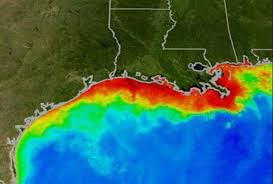Dead Zone:

National Oceanic and Atmospheric Administration (NOAA) is forecasting an above-average summer “dead zone” in the Gulf of Mexico covering approximately 5,827 square miles.
- The term “dead zone” or “hypoxia” refers to low-oxygen areas in the world’s lakes and oceans.
- Because most organisms need oxygen to live, few organisms can survive in hypoxic conditions.
- That is why these areas are called dead zones.
- Hypoxic zones can occur naturally, but human activities can also lead to the creation of new dead zones or the enhancement of existing ones.
- Dead Zone occurs as a result of eutrophication, which happens when a body of water is inundated with too many nutrients, such as phosphorus and nitrogen.
- At normal levels, an organism called cyanobacteria – or blue-green algae – feeds on these nutrients.
- With too many nutrients, it can cause an overgrowth of algae in a short period of time, also called algae blooms.
- Dead zones form when the algae die, sink to the bottom, and are decomposed by bacteria—a process that strips dissolved oxygen from the surrounding water.
- Dense algal blooms also block sunlight, which prevents underwater grasses from growing.
- In turn, the animals that depend on these grasses for food and shelter suffer, as well.
- Human activities mainly cause these excess nutrients to be washed into the ocean, which is why dead zones are often located near inhabited coastlines.




